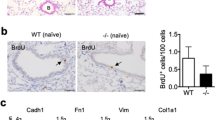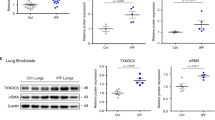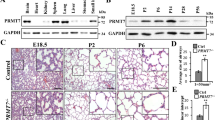Abstract
p38 is associated with a macromolecular tRNA synthetase complex1. It has an essential role as a scaffold for the complex, and genetic disruption of p38 in mice causes neonatal lethality2. Here we investigated the molecular mechanisms underlying lethality of p38-mutant mice. p38-deficient mice showed defects in lung differentiation and respiratory distress syndrome. p38 was found to interact with FUSE-binding protein (FBP), a transcriptional activator of c-myc3. Binding of p38 stimulated ubiquitination and degradation of FBP, leading to downregulation of c-myc, which is required for differentiation of functional alveolar type II cells. Transforming growth factor-β (TGF-β) induced p38 expression and promoted its translocation to nuclei for the regulation of FBP and c-myc. Thus, this work identified a new activity of p38 as a mediator of TGF-β signaling and its functional importance in the control of c-myc during lung differentiation.
This is a preview of subscription content, access via your institution
Access options
Subscribe to this journal
Receive 12 print issues and online access
$209.00 per year
only $17.42 per issue
Buy this article
- Purchase on SpringerLink
- Instant access to full article PDF
Prices may be subject to local taxes which are calculated during checkout






Similar content being viewed by others
References
Quevillon, S., Robinson, J.-C., Berthonneau, E., Siatecka, M. & Mirande, M. Macromolecular assemblage of aminoacyl-tRNA synthetases: identification of protein-protein interactions and characterization of a core protein. J. Mol. Biol. 285, 183–195 (1999).
Kim, J.Y. et al. p38 is essential for the assembly and stability of macromolecular tRNA synthetase complex: implications for its physiological significance. Proc. Natl. Acad. Sci. USA 99, 7912–7916 (2002).
Duncan, R. et al. A sequence-specific, single-strand binding protein activates the far upstream element of c-myc and defines a new DNA-binding motif. Genes Dev. 8, 465–480 (1994).
Nicolaides, N.C., Kinzler, K.W. & Vogelstein, B. Analysis of the 5′ region of PMS2 reveals heterogeneous transcripts and a novel overlapping gene. Genomics 29, 329–334 (1995).
Harding, H.P. et al. Regulated translation initiation controls stress-induced gene expression in mammalian cells. Mol. Cell 6, 1099–1108 (2000).
Ben-Izhak, O. et al. Ki67 antigen and PCNA proliferation markers predict survival in anorectal malignant melanoma. Histopathology 41, 519–525 (2002).
Semenza, G. Signal transduction to hypoxia-inducible factor 1. Biochem. Pharmacol. 64, 993–998 (2002).
Griese, M. Pulmonary surfactant in health and human lung diseases: state of the art. Eur. Respir. J. 13, 1455–1476 (1999).
Weaver, T.E. & Conkright, J.J. Function of surfactant proteins B and C. Annu. Rev. Physiol. 63, 555–578 (2001).
Lawson, P.R. & Reid, K.B. The roles of surfactant proteins A and D in innate immunity. Immunol. Rev. 173, 66–78 (2000).
Kalina, M., Mason, R.J. & Shannon, J.M. Surfactant protein C is expressed in alveolar type II cells but not in Clara cells of rat lung. Am. J. Respir. Cell Mol. Biol. 6, 594–600 (1992).
Sugarara, K., Iyama, K., Sano, K. & Morioka, T. Differential expressions of surfactant protein SP-A, SP-B, and SP-C mRNAs in rats with streptozotocin-induced diabetes demonstrated by in situ hybridization. Am. J. Respir. Cell Mol. Biol. 11, 397–404 (1994).
Wang, X., Avigan, M. & Norgren, R.B. Jr. FUSE-binding protein is developmentally regulated and is highly expressed in mouse and chicken embryonic brain. Neurosci. Lett. 252, 191–194 (1998).
Duncan, R., Collins, I., Tomonaga, T., Zhang, T. & Levens, D. A unique transactivation sequence motif is found in the carboxyl-terminal domain of the single-strand-binding protein FBP. Mol. Cell. Biol. 16, 2274–2282 (1996).
Davis-Smyth, T., Duncan, R.C., Zheng, T., Michelotti, G. & Levens, D. The far upstream element-binding proteins comprise an ancient family of single-strand DNA-binding transactivators. J. Biol. Chem. 271, 31679–31687 (1996).
Zhou, M., Wu, X. & Ginsberg, H.N. Evidence that a rapidly turning over protein, normally degraded by proteasomes, regulates hsp72 gene transcription in HepG2 cells. J. Biol. Chem. 271, 24769–24775 (1996).
Sanford, L.P. et al. TGFβ2 knockout mice have multiple developmental defects that are non-overlapping with other TGFβ knockout phenotypes. Development 124, 2659–2670 (1997).
Kaartinen, V. et al. Abnormal lung development and cleft palate in mice lacking TGFβ3 indicates defects of epithelial-mesenchymal interaction. Nat. Genet. 11, 415–421 (1995).
Markowitz, S. et al. Inactivation of the type II TGF-β receptor in colon cancer cells with microsatellite instability. Science 268, 1336–1338 (1995).
Hannon, G.J. & Beach, D. p15INK4B is a potential effector of TGF-β-induced cell cycle arrest. Nature 371, 257–261 (1994).
Hocevar, B.A., Brown, T.L. & Howe, P.H. TGF-β induces fibronectin synthesis through a c-Jun N-terminal kinase-dependent, Smad4-independent pathway. EMBO J. 18, 1345–1356 (1999).
Liu, J. et al. The FBP interacting repressor targets TFIIH to inhibit activated transcription. Mol. Cell 5, 331–341 (2000).
Guo, Q.M. et al. Identification of c-myc responsive genes using rat cDNA microarray. Cancer Res. 60, 5922–5928 (2000).
Schuhmacher, M. et al. The transcriptional program of a human B cell line in response to Myc. Nucleic Acids Res. 29, 397–406 (2001).
Ehrhardt, A. et al. Development of pulmonary bronchiolo-alveolar adenocarcinomas in transgenic mice overexpressing murine c-myc and epidermal growth factor in alveolar type II pneumocytes. Br. J. Cancer 84, 813–818 (2001).
Chinoy, M.R., Chi, X. & Cilley, R.E. Down-regulation of regulatory proteins for differentiation and proliferation in murine fetal hypoplastic lungs. Pediatr. Pulmonol. 32, 129–141 (2001).
Todaro, G.J. & Green, H. Quantitative studies of the growth of mouse embryo cells in culture and their development into established lines. J. Cell Biol. 17, 299–313 (1963).
Kang, J. et al. Heat shock protein 90 mediates protein-protein interactions between human aminoacyl-tRNA synthetases. J. Biol. Chem. 275, 31682–31688 (2000).
Rho, S.B. et al. Genetic dissection of protein-protein interactions in multi-tRNA synthetase complex. Proc. Natl. Acad. Sci. USA 96, 4488–4493 (1999).
Acknowledgements
This work was supported by a grant of National Creative Research Initiatives from Ministry of Science and Technology, Korea.
Author information
Authors and Affiliations
Corresponding author
Ethics declarations
Competing interests
The authors declare no competing financial interests.
Rights and permissions
About this article
Cite this article
Kim, M., Park, BJ., Kang, YS. et al. Downregulation of FUSE-binding protein and c-myc by tRNA synthetase cofactor p38 is required for lung cell differentiation. Nat Genet 34, 330–336 (2003). https://doi.org/10.1038/ng1182
Received:
Accepted:
Published:
Issue Date:
DOI: https://doi.org/10.1038/ng1182



